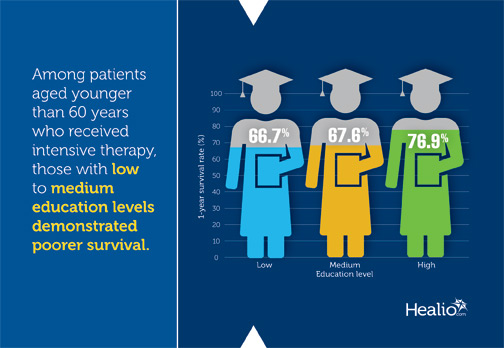Highly educated patients with acute myeloid leukemia show better survival in a universal health system
Education level impacted allogeneic hematopoietic stem cell transplantation rates among younger patients with acute myeloid leukemia in a country with universal health care, according to researchers in Denmark.
“Most studies on the impact of socioeconomic status on acute myeloid leukemia outcome have focused on insurance and race,” Lene Sofie Granfeldt Østgård, MD, PhD, of Aarhus University Hospital, and colleagues wrote. “These observations may not be generalizable to patients treated in the several countries worldwide offering universal health coverage.”
Østgård and colleagues performed a population-based study of all patients in Denmark who had acute myeloid leukemia between 2000 and 2014 (n = 2,992). The researchers used logistic regression to compare intensity of treatment, allogeneic transplantation rates and response rates by income level and education. They used Cox regression analysis to compare survival after adjustment for sex, age, clinical prognostic markers and socioeconomic status.
Most patients (53.1%) underwent intensive chemotherapy. Highly educated patients received allogeneic transplantation more frequently than those with less education (16.3% vs. 8.7%).
Among patients aged younger than 60 years who received intensive therapy, those with low to medium education levels demonstrated increased mortality. One-year survival was 66.7% (HR = 1.47; 95% CI, 1.11-1.93) among those with low education levels and 67.6% (HR = 1.55; 95% CI, 1.21-1.98) among those with medium education levels compared with 76.9% among those with higher levels of education.
Patients with high levels of education comprised the only group to show survival improvements. In these patients, 5-year survival rose throughout the study period, from 39% between 2000 and 2004 to 58% between 2010 and 2014, which widened the survival gap between highly educated patients and those with limited education.
In patients aged older than 60 years, those with lower levels of education received less intensive therapy than those with higher education (30% vs. 48%; adjusted OR = 0.65; 95% CI, 0.44-0.98). Intensive treatment did not appear to affect survival or remission rates.
Income levels were not linked with intensity of therapy, likelihood of remission or survival (high income, adjusted HR = 1; medium income, adjusted HR = 0.96; 95% CI, 0.82-1.12; low income, adjusted HR = 1.06; 95% CI, 0.88-1.27).
“In a universal health care system, income does not affect acute myeloid leukemia survival,” Østgård and colleagues wrote. “Conversely, education has a major impact on survival in patients younger than 60 years of age, which is likely related to the higher allogeneic hematopoietic stem cell transplantation rate and superior outcome in better-educated patients. Targeted initiatives toward less-educated patients may increase allogeneic hematopoietic stem cell transplantation rates and improve overall prognosis of acute myeloid leukemia.” – by Andy Polhamus
Disclosures: Østgård reports consulting or advisory roles with Abbvie, Bristol-Myers Squibb, MSD and Pfizer, as well as travel, accommodations and expenses from Pfizer. Please see the full study for a list of all other authors’ relevant financial disclosures.


